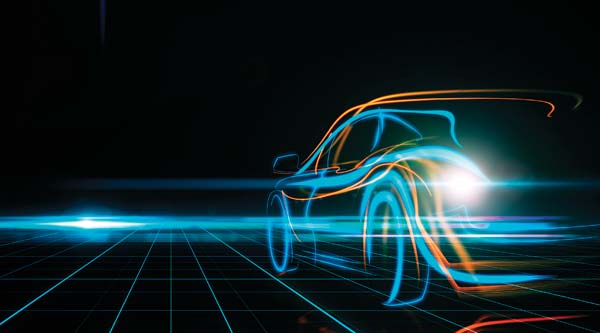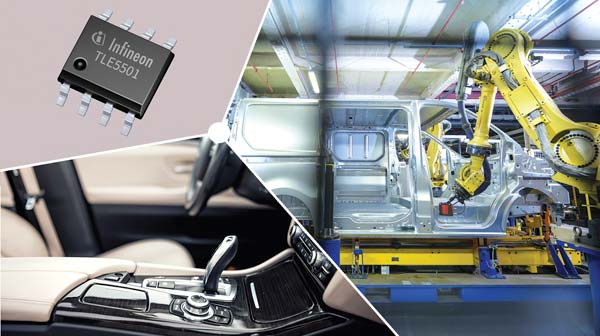 On the road to autonomous driving, cars are being equipped with an increasing number of sensors. Magnetic field sensors based on the Hall Effect offer several advantages over other measuring principles and technologies. Current models also meet the more stringent requirements of ISO 26262:2018. Hall sensors detect the voltage difference that results when a magnetic field is applied to a semiconductor perpendicular to the direction of flow of the electric current. Since this Hall voltage is directly proportional to the strength of the magnetic field, the sensors, together with a permanent magnet, can indirectly measure numerous variables, e.g. rotation, speed, distance, pressure, angle, and fill level. Since the sensor measures the strength of a magnetic field around a conductor with a steady flow of current, it can also measure current without contact. Similarly, it also detects the other parameters without contact, meaning that it operates without any wear and tear and therefore reliably delivers precise measurements, even in long-term operation.
On the road to autonomous driving, cars are being equipped with an increasing number of sensors. Magnetic field sensors based on the Hall Effect offer several advantages over other measuring principles and technologies. Current models also meet the more stringent requirements of ISO 26262:2018. Hall sensors detect the voltage difference that results when a magnetic field is applied to a semiconductor perpendicular to the direction of flow of the electric current. Since this Hall voltage is directly proportional to the strength of the magnetic field, the sensors, together with a permanent magnet, can indirectly measure numerous variables, e.g. rotation, speed, distance, pressure, angle, and fill level. Since the sensor measures the strength of a magnetic field around a conductor with a steady flow of current, it can also measure current without contact. Similarly, it also detects the other parameters without contact, meaning that it operates without any wear and tear and therefore reliably delivers precise measurements, even in long-term operation.
Simple Hall sensors are often used as switches, e.g. in seat belt buckles, windshield wipers, or engine switching systems. In this context, a threshold value for the magnetic field strength is saved in the sensor. If the detected value reaches this threshold, the switching state of the sensor changes. For example, Melexis’ MLX92241, with its built-in blocking capacitors, makes a local board-less design possible with operation directly on a cable harness, e.g. for detecting whether the seat belt is fastened. Its EEPROM memory can store customer-specific threshold values for the switching points, output polarity, Ioff current, and temperature compensation coefficient for the magnetic material. The programmable negative temperature coefficient can be used to compensate for the behavior of permanent magnets that become weaker at high temperatures. The Hall sensor elements are equipped with safety mechanisms to protect against electrostatic discharge, reverse polarity, and thermal overload. They meet the requirements of ASIL A.
Linear hall sensors also measure distances and rotation
Hall sensors with linear output signals are necessary to measure distances or rotational movements. They not only recognize the states “on” and “off,” but also output an analog signal proportional to the magnetic field strength. The A/D converter, which is integrated into either the MCU or the Hall sensor, converts the analog signal into a digital signal. To control other system components, the MCU then outputs a proportional pulse-width modulated (PWM) signal or a data stream compatible with the SENT automotive sensor bus system. Some of the latest-generation Hall sensors have the PWM interface and the SENT interface built right into the sensor itself.
When using Hall sensors that merely detect the magnetic field perpendicular to the chip plane, large and cost-intensive additional assemblies are often required. More advanced solutions integrate an increasing number of sensors as well as signal processing and calculation functions, often eliminating the need for additional components and allowing additional parameters to be measured.
 For example, vertical Hall sensors detect not only the magnetic field perpendicular to the direction of the current, but also that parallel to the direction of the current or to the chip plane. In addition to the amplitude of the magnetic field, 2D sensors also detect its direction. This can be used to determine an engine’s direction of rotation, for example. For example, the Hall-based Xensiv TLE4988C from Infineon makes it possible to quickly measure the position of the camshaft. One major benefit for module manufacturers is the reduced dependence on rare-earth backbiased magnets; the sensor is optimized for Fe, SmCo, and NdFe, for example. Automatic in-vehicle calibration takes the tolerances of ferromagnetic wheels and magnetic encoders as well as the mounting tolerances of the sensor takes into account, thereby ensuring extremely accurate sensing in real application environments. The TLE4988C comes inside a PG-SSO-3-52 camshaft sensor package with Sn plating as well as a 3-wire voltage I/F and increased supply/output capacitance of 220/1.8nF for higher EMC robustness.
For example, vertical Hall sensors detect not only the magnetic field perpendicular to the direction of the current, but also that parallel to the direction of the current or to the chip plane. In addition to the amplitude of the magnetic field, 2D sensors also detect its direction. This can be used to determine an engine’s direction of rotation, for example. For example, the Hall-based Xensiv TLE4988C from Infineon makes it possible to quickly measure the position of the camshaft. One major benefit for module manufacturers is the reduced dependence on rare-earth backbiased magnets; the sensor is optimized for Fe, SmCo, and NdFe, for example. Automatic in-vehicle calibration takes the tolerances of ferromagnetic wheels and magnetic encoders as well as the mounting tolerances of the sensor takes into account, thereby ensuring extremely accurate sensing in real application environments. The TLE4988C comes inside a PG-SSO-3-52 camshaft sensor package with Sn plating as well as a 3-wire voltage I/F and increased supply/output capacitance of 220/1.8nF for higher EMC robustness.
The Xensiv TLE5501 analog angle sensor from Infineon is based on TMR (tunneling magnetoresistive) technology. It features high detection sensitivity with a high output voltage, eliminating the need for an internal amplifier and allowing the sensor to be connected directly to the microcontroller. In addition, TMR technology features minimal temperature drift, which reduces the need for external calibration and compensation. The TLE5501 uses 360° angle measurement to detect the orientation of a magnetic field by measuring the sine and cosine angle components using TMR elements. It outputs the raw signals as a differential output signal. Due to the high bridge output voltage, additional signal amplification is not necessary. The TLE5501 is available in AEC-Q100 and automotive ASIL versions and is suitable for angular position sensing, steering angle sensing, safety applications, and BLDC motor commutation.
The third dimension
3D Hall sensor technology combines lateral and vertical Hall sensors and as a result, can detect the strength of the magnetic field in all three dimensions. This type of sensor makes it possible to detect the absolute rotary or linear position of each moving magnet.
The MLX92256, for example, is equipped with lateral sensing. Designed specifically for use in window lift systems, it integrates a voltage regulator, two Hall sensors – one with IMC (integrated magnetic concentrator) and both with an advanced offset cancellation system – and two open-drain output drivers all in a single package. It is available in two versions. The MLX92256LSE-AAA-000 toggles the pulse signal when there is a change in the lateral or vertical component, while the direction pin only changes in the event of a change in direction. The MLX92256LSE-ABA-000 is equipped with two speed outputs, one for the perpendicular field and one for the lateral field.
The MLX90371/MLX90372 Triaxis position sensors from Melexis are now available in the third generation. They combine a magnetic Triaxis Hall front-end, an analog/digital signal conditioner, a DSP (digital signal processor) for signal processing, and an output stage driver. They are immune to stray fields up to 4 kA/m (or 5 mT) as they occur as a result of the increasing electrification of vehicles, especially electric and hybrid vehicles. Since they can also work with a weak magnetic field, smaller and cheaper magnets are sufficient. This not only results in cost benefits, but also space savings. The MLX90371 is an ASILB SEooC (safety element out of context) to ISO 26262 and offers an analog or PWM output. The MLX90372 is an ASIL-C SEooC to ISO 26262 and has a SENT or PWM output. Both meet the EMC requirements of automotive OEMs and are specified for operating temperatures up to 160°C. For applications with particularly stringent safety requirements such as accelerator pedal position sensing, the MLX90372 is also available in a “dual die” (fully redundant) TSSOP-16 package for redundant sensing.
TDK-Micronas offers a programmable 3D sensor family for position sensing. It consists of three members: the HAL 3900 with an SPI interface, the HAL 3930 with a PWM/SENT interface and switch output (configurable as a high/low-side switch), and the HAL 3980 with a PSI5 interface. The sensors can suppress external magnetic stray fields by using an array of Hall plates. Only a simple two-pole magnet is required to measure a rotation angle, ideally placed over the sensitive area in an end of-shaft configuration. ´The sensors can also be used for off-axis measurements. They can measure an angular range of 360°, linear movements, and a 3D position, making them ideal for steering angle position sensing. Depending on the device, it is possible to transmit temperature-compensated values of BX, BY, BZ, or up to two calculated angles. The HAL-39xy sensors operate in an ambient temperature range from –40°C to +160°C; they are ASIL B-ready and designed as SEooC according to ISO 26262 for automotive applications.
Rugged and reliable
The examples show that not only have tremendous advancements been made in sensor technology to meet the increasing demands in cars, but that their design has also evolved. Many of the latest models also meet the more stringent guidelines of ISO 26262:2018, some as ASIL-C SEooCs. Redundancy and safety functions contribute to this as well as measures to improve EMC. Corresponding packages ensure the sensors are resistant to moisture, dust, and dirt. For use in high-temperature environments, Hall sensors are specified for operating temperatures of up to 170°C. As a result of these features, they play a key role on the road to autonomous driving.
Autor: Edgar Schaefer, Automotive FAE
Rutronik | https://www.rutronik.com
![]()



